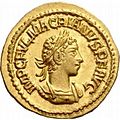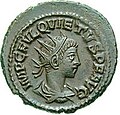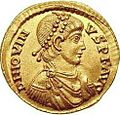| Coin |
Name |
Emperor |
Tenure |
Life details & notes |
|---|
| Verus |
Elagabalus
(r. 218–222) |
c. 218
(Syria) |
Senator and commander of the Legio III Gallica; proclaimed emperor in Tyre. |
| Gellius Maximus |
Son of a doctor; commander of the Legio IV Scythica. |
| Taurinius |
Severus Alexander
(r. 222–235) |
c. 232
(Syria) |
Governor in Moesia; mentioned by Polemius Silvius. Probably a descendant of king Antiochus IV of Commagene and Marcus Antonius. |
Seleucus
(Gaius) Julius Antonius Seleucus |
Former suffect consul; proclaimed emperor against his will. Drowned himself in the Euphrates to avoid punishment. |
| Ovinius Camillus |
|
Fictitious usurper of the Historia Augusta |
Magnus
Gaius Petronius Magnus |
Maximinus Thrax
(r. 235–238) |
late 235
(in Germania) |
A patritian ex-consul; said to have been hailed emperor after Alexander's murder. Herodian suggests that he was actually incriminated.[11] |
Quartinus
(Titus Fulvius) Quartinus |
late 235 / early 236[a]
(in Mesopotamia) |
Ex-consul; reluctantly hailed by troops loyal to Alexander. He was later killed by the same man who proclaimed him emperor.[11] |
Sabinian
Marcus Asinius Sabinianus |
Gordian III
(r. 238–244) |
240
(Africa) |
Ex-consul and proconsul of Africa; killed by the governor of Mauretania. |
 |
Pacatian
Marcus Fulvius Ru(fus) Jotapianus |
Philip the Arab
(r. 244–249) |
c. 248 / 249
(Danube) |
Commander in Moesia or Pannonia and a former consul; defeated by Decius and killed by his own soldiers shortly after. His rule came on (or shortly after) Rome's 1000th anniversary. |
 |
Jotapian
Marcus Fulvius Ru(fus) Jotapianus |
c. 249
(Levant) |
A member of Near East nobility, perhaps related to the ancient kings of Commagene, claimed descent from Alexander the Great. Revolted for several months in Syria and Cappadocia in response to the heavy taxation policies of Priscus, Philip's brother and governor of the East. Like many, Jopatian was eventually killed by his own soldiers. |
 |
Silbannacus
Mar(cius?) Silbannacus |
c. 249 (?)
(Gaul?) |
Only known for two coins, possibly an usurper in Gaul (or perhaps Rome). According to one view, he may be related to Marcia Otacilia Severa, Philip's wife. |
 |
Sponsianus |
c. 249 (??)
(Balkans?) |
Existence disputed, only known for a few coins found in Transylvania that reuse old Republican denarii. |
Licinian
Julius Valens Licinianus |
Decius
(r. 249–251) |
c. 251 |
Biefly mentioned by Aurelius Victor; fictionalized as Valens Senior in the Historia Augusta. Defeated by the (future emperor) Valerian.[22] |
Priscus
Titus Julius Priscus |
c. 251 |
Governor of Macedonia, proclaimed himself emperor in Philippopolis during a siege by Goths. |
 |
Uranius Antoninus
Lucius Julius Aurelius Sulpicius Severus Uranius Antoninus |
Valerian
(r. 253–260) |
c. 253 / 254
(Syria) |
Born as Sampsiceramus, initially a priest of the cult of Elagabal, likely a descendant of Elagabalus. Proclaimed emperor after successfully defending Emesa from the Persian forces of Shapur I; fate unknown. Most likely the same "Uranius" said to have revolted against Severus Alexander. |
| Ingenuus |
Gallienus
(r. 253–268) |
c. 260
(Pannonia) |
Governor of Pannonia, proclaimed in Sirmium by the legions of Moesia after the capture of Valerian, defeated and killed and in Mursa. |
 |
Regalianus
P(ublius) C(assius) Regalianus |
c. 260
(Pannonia) |
A native of Dacia, commander in Illyricum. Proclaimed emperor in Moesia but killed shortly after, perhaps by his own troops upon Gallienus' arrival. |
 |
Macrianus Minor
Titus Fulvius Junius Macrianus |
c. 260 – 261
(in the East) |
Sons of Macrianus Major, Valerian's quartermaster general, who was proclaimed emperor by the praetorian prefect Balista but refused due to his age and health, instead proclaiming his two sons, both legates, as joint emperors and consuls. They quickly took over most of the East (Egypt, Syria and Asia) while Gallienus fought in the West. Both Macrianus were eventually defeated at Illyricum by Aureolus, while Quietus, the younger brother, was sieged by Odaenathus in Emesa with Ballista and killed. |
 |
Quietus
Titus Fulvius Junius Quietus |
| Valens "Thessalonicus" |
c. 261
(Achaia/Macedonia) |
Proconsul of Achaia, probably gained his nickname after defending Thessalonica. Proclaimed emperor during his confrontation against Piso, one of Macrianus' generals. Valens defeated him, but was killed by his own soldiers shortly after. |
Aemilian II
Lucius Mussius Aemilianus "Aegippius" |
c. 261 – 262
(Egypt) |
A distinguished officer who supported the revolt of Macrianus, claimed imperial power after their deaths, probably to avoid punishment. Defeated by Aurelius Theodotus. |
| Memor |
c. 262 (?) |
A mauri mentioned by Zosimus and Peter the Patrician (c. 550 AD). Likely a follower of Macrianus, he may have never actually claimed imperial power. |
Aureolus
(Manius Acilius) Aeolus |
268
(Northern Italy) |
Native of Dacia and Gallienus' right hand man. Defeated the usurpers Ingenuus (260) and Macrianus (261), but later allied himself with Postumus against Gallienus. He proclaimed himself emperor following Gallienus' death, but was quickly killed by Claudius' troops after surrending to him. |
| Thirty Tyrants |
|
Thirty-two pretenders who appear in the Historia Augusta, most of them fictitious. |
|
The Gallic Empire was breakaway part of the Roman Empire that, unlike most usurper-ran territories, functioned de facto as a separate state from 260 to 274. It had its own capital (Trier), a clear succession of emperors, its own pair of yearly-elected consuls, and even its own usurpers. At its height, the Empire controlled all Western European provinces: Hispania, Gaul and Britannia. The term "Gallic Empire" and "Gallic Emperor" are modern conventions; its rulers continued to use the standard imperial titulature without changes. |
 |
Postumus
Marcus Cassianius Latinius Postumus |
Gallienus
(r. 253–268) |
c. 260 – April/August 269
(about 9 years) |
Governor of Germania, proclaimed emperor after a military victory, after which he killed Gallienus' son Saloninus at Cologne. Established a court in Trier, but made no moves against the Emperor in Rome. He was killed by his troops in the aftermath of Laelian's usurpation, as he did not allow them to sack Mainz. |
 |
Laelian
Ulpius Cornelius Laelianus |
Claudius Gothicus
(r. 268–270) |
mid-269
(Germania, 2 months or less) |
General under Postumus, revolted in Mainz in February or June 269, possibly in coordination with Claudius's forces, which constantly attacked Southern Germania. He was related to the Hispanic emperor Trajan (r. 98–117), which made him earn support from that region. Laelian was quickly defeated by Postumus; Hispania switched allegiance to Claudius II shortly after. |
 |
Marius
Marcus Aurelius Marius |
c. 269
(a few months, more than Laelian) |
A blacksmith that was proclaimed emperor in Mainz after Laelian and Postumus' demise, but was killed shortly after. Ancient sources give him a reign of only a couple of days, but this is impossible given the amount of coinage produced during his reign. |
 |
Victorinus
Marcus Piavonius Victorinus |
c. 269 – 271
(about 3 years) |
Proclaimed emperor after Marius' death with the support of his mother Victoria, a wealthy noblewoman who probably contributed to the fall of Postumus. Failed to maintain Hispania and faced revolts in central Germania. Killed by one of his officers, whose wife Victorinus had supposedly seduced. |
 |
Domitian II
Domitianus |
Aurelian
(r. 270–275) |
c. 271
(very shortly) |
Obscure figure that briefly rebelled in Gaul, perhaps against Victorinus. |
 |
Tetricus
Gaius Esuvius Tetricus |
c. 271 – 274
(about 3 years) |
Governor of Aquitania; proclaimed emperor at Bordeaux with the support of Victoria. He surrendered to Aurelian after the Battle of Châlons, although Tetricus appears to have been secretly arranged his abdication with the Emperor, who pardon him and appointed him as governor of Lucania (Southern Italy). |
 |
Tetricus II
Gaius Esuvius Tetricus |
c. 273 – 274
(caesar under Tetricus I) |
Young son of Tetricus, almost nothing known except that he lived on to have a distinguished senatorial career. There is some debate on whether he was proclaimed augustus on the final weeks on the Gallic empire, as the evidence (coins) for this are rare and of disputed authenticity. |
| Faustinus |
274 |
Governor of Gallia Belgica, rebelled against Tetricus, who was forced to ask Aurelian for help. Not known if he actually claimed the imperial title.[46] |
|
The Palmyrene Empire was a short-lived breakaway state centered around the city of Palmyra. It encompassed the Roman provinces of Syria Palaestina, Arabia Petraea, and Egypt, as well as large parts of Asia Minor. Chaos consumed the East following the capture of Valerian and the revolts of Macrianus, but the territories were eventually pacified by Odaenathus, who was named Dux Romanorum ("leader of the Romans") and Corrector totius orientis (essentially "governor of all the East") by Gallienus, effectively turning the territory into a semi-independent entity. Odaenathus was proclaimed "King of Kings" (rex regum), but remained loyal to the Emperor. He was murdered by his son Hairan in 267, who was in turn killed by his cousin Maeonius. The throne went to Odaenathus' young son Vaballathus, who reigned under the regency of her mother Zenobia. |
 |
Vaballathus
Lucius Julius Aurelius Septimius Vaballathus Athenodorus |
Aurelian
(r. 270–275) |
272[b]
(1 year) |
Young son of Zenobia and Odaenathus, succeeded his father as dux, corrector and rex of Palmyra with the addition of the titles consul and imperator, although all real power was held by Zenobia. |
 |
Zenobia |
A remarkable and cultured stateswoman; wife of Odaenathus and mother of Vaballathus, de facto ruler of the East since 267, assumed the title of augusta in 271/272, after conquering Egypt. She first attempted to rule as a co-equal to Aurelian, with no results. She was spared and retired with his son, later marrying a senator. |
| Antiochus |
273
(very briefly) |
Son of Zenobia, perhaps still a child. Proclaimed emperor during a revolt against the restored Roman rule in Palmyra. He was spared. |
|
| Septimius |
Aurelian
(r. 270–275) |
c. 271
(Dalmatia) |
Killed by his own men. Briefly mentioned by Zosimus and Victor. |
| Urbanus |
??? |
Nothing known, only briefly mentioned by Zosimus. |
 |
Bonosus |
Probus
(r. 276–282) |
280
(Germania) |
Commanders in Germany, proclaimed emperors at Cologne (alternatively, they were proclaimed separately, but soon joined forces). Bonosus committed suicide after facing Probus' army, while Proculus was either killed in battle or executed soon after. |
 |
Proculus |
 |
Saturninus
Gaius Julius Sallustius Saturninus Fortunatianus |
c. 281
(Egypt) |
A former consul native of Africa and commander in the East, revolted in Antioch. Hoped to gain recognition by Probus, with no results. He was killed by his own soldiers near Apamea in the ensuing confrontation. |
 |
Julian of Pannonia
Marcus Aurelius Sabinus Julianus |
Carinus
(r. 283–285) |
c. November 284 –
c. February 285
(Pannonia, 3 months or less) |
Governor of Venice, revolted in north-eastern Italy after the death of Numerian, but was quickly defeated near Verona by Carinus, who used Julian's soldiers to fight the approaching Diocletian. Sometimes treated as two emperors, one Marcus Aurelius Julianus, in Pannonia, and another Sabinius Julianus, in Italy. |
Amandus
(rebel) |
Diocletian
(r. 286–305, East) |
285
(Gaul) |
Revolted in Gaul after the death of Carinus with Aelianus; quickly killed by Maximian. Once thought to be an usurper who minted coins in their names.[60] |
 |
Domitian III
Lucius Domitius Domitianus |
c. 297
(Egypt) |
Proclaimed in Egypt, almost nothing known. Chronology uncertain. |
 |
Aurelius Achilleus |
297–298
(Egypt) |
Proclaimed in Egypt, almost nothing known. |
 |
Carausius
Marcus Aurelius Mausaeus Carausius |
Maximian
(r. 286–305, West) |
286–293
(7 years, in Britain) |
Naval commander of humble birth, rebelled and proclaimed himself emperor in Britain (and Northern Gaul) after being sentenced to death for allegedly keeping the booty of the pirates he fought. Murdered by Allectus after a military defeat. |
 |
Allectus |
293–296
(3 years, in Britain) |
Killed by the praetorian prefect Asclepiodotus by orders of Constantius I. |
































